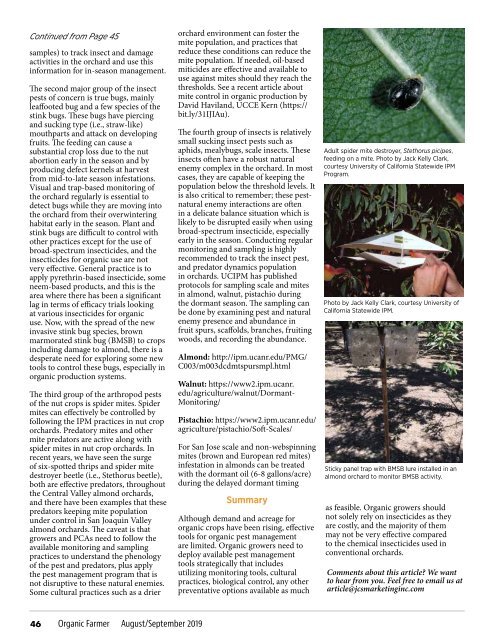Organic Farmer Aug/Sept 2019
- No tags were found...
You also want an ePaper? Increase the reach of your titles
YUMPU automatically turns print PDFs into web optimized ePapers that Google loves.
Continued from Page 45<br />
samples) to track insect and damage<br />
activities in the orchard and use this<br />
information for in-season management.<br />
The second major group of the insect<br />
pests of concern is true bugs, mainly<br />
leaffooted bug and a few species of the<br />
stink bugs. These bugs have piercing<br />
and sucking type (i.e., straw-like)<br />
mouthparts and attack on developing<br />
fruits. The feeding can cause a<br />
substantial crop loss due to the nut<br />
abortion early in the season and by<br />
producing defect kernels at harvest<br />
from mid-to-late season infestations.<br />
Visual and trap-based monitoring of<br />
the orchard regularly is essential to<br />
detect bugs while they are moving into<br />
the orchard from their overwintering<br />
habitat early in the season. Plant and<br />
stink bugs are difficult to control with<br />
other practices except for the use of<br />
broad-spectrum insecticides, and the<br />
insecticides for organic use are not<br />
very effective. General practice is to<br />
apply pyrethrin-based insecticide, some<br />
neem-based products, and this is the<br />
area where there has been a significant<br />
lag in terms of efficacy trials looking<br />
at various insecticides for organic<br />
use. Now, with the spread of the new<br />
invasive stink bug species, brown<br />
marmorated stink bug (BMSB) to crops<br />
including damage to almond, there is a<br />
desperate need for exploring some new<br />
tools to control these bugs, especially in<br />
organic production systems.<br />
The third group of the arthropod pests<br />
of the nut crops is spider mites. Spider<br />
mites can effectively be controlled by<br />
following the IPM practices in nut crop<br />
orchards. Predatory mites and other<br />
mite predators are active along with<br />
spider mites in nut crop orchards. In<br />
recent years, we have seen the surge<br />
of six-spotted thrips and spider mite<br />
destroyer beetle (i.e., Stethorus beetle),<br />
both are effective predators, throughout<br />
the Central Valley almond orchards,<br />
and there have been examples that these<br />
predators keeping mite population<br />
under control in San Joaquin Valley<br />
almond orchards. The caveat is that<br />
growers and PCAs need to follow the<br />
available monitoring and sampling<br />
practices to understand the phenology<br />
of the pest and predators, plus apply<br />
the pest management program that is<br />
not disruptive to these natural enemies.<br />
Some cultural practices such as a drier<br />
orchard environment can foster the<br />
mite population, and practices that<br />
reduce these conditions can reduce the<br />
mite population. If needed, oil-based<br />
miticides are effective and available to<br />
use against mites should they reach the<br />
thresholds. See a recent article about<br />
mite control in organic production by<br />
David Haviland, UCCE Kern (https://<br />
bit.ly/31IJIAu).<br />
The fourth group of insects is relatively<br />
small sucking insect pests such as<br />
aphids, mealybugs, scale insects. These<br />
insects often have a robust natural<br />
enemy complex in the orchard. In most<br />
cases, they are capable of keeping the<br />
population below the threshold levels. It<br />
is also critical to remember; these pestnatural<br />
enemy interactions are often<br />
in a delicate balance situation which is<br />
likely to be disrupted easily when using<br />
broad-spectrum insecticide, especially<br />
early in the season. Conducting regular<br />
monitoring and sampling is highly<br />
recommended to track the insect pest,<br />
and predator dynamics population<br />
in orchards. UCIPM has published<br />
protocols for sampling scale and mites<br />
in almond, walnut, pistachio during<br />
the dormant season. The sampling can<br />
be done by examining pest and natural<br />
enemy presence and abundance in<br />
fruit spurs, scaffolds, branches, fruiting<br />
woods, and recording the abundance.<br />
Almond: http://ipm.ucanr.edu/PMG/<br />
C003/m003dcdmtspursmpl.html<br />
Walnut: https://www2.ipm.ucanr.<br />
edu/agriculture/walnut/Dormant-<br />
Monitoring/<br />
Pistachio: https://www2.ipm.ucanr.edu/<br />
agriculture/pistachio/Soft-Scales/<br />
For San Jose scale and non-webspinning<br />
mites (brown and European red mites)<br />
infestation in almonds can be treated<br />
with the dormant oil (6-8 gallons/acre)<br />
during the delayed dormant timing<br />
Summary<br />
Although demand and acreage for<br />
organic crops have been rising, effective<br />
tools for organic pest management<br />
are limited. <strong>Organic</strong> growers need to<br />
deploy available pest management<br />
tools strategically that includes<br />
utilizing monitoring tools, cultural<br />
practices, biological control, any other<br />
preventative options available as much<br />
Adult spider mite destroyer, Stethorus picipes,<br />
feeding on a mite. Photo by Jack Kelly Clark,<br />
courtesy University of California Statewide IPM<br />
Program.<br />
Photo by Jack Kelly Clark, courtesy University of<br />
California Statewide IPM.<br />
Sticky panel trap with BMSB lure installed in an<br />
almond orchard to monitor BMSB activity.<br />
as feasible. <strong>Organic</strong> growers should<br />
not solely rely on insecticides as they<br />
are costly, and the majority of them<br />
may not be very effective compared<br />
to the chemical insecticides used in<br />
conventional orchards.<br />
Comments about this article? We want<br />
to hear from you. Feel free to email us at<br />
article@jcsmarketinginc.com<br />
46<br />
<strong>Organic</strong> <strong>Farmer</strong> <strong>Aug</strong>ust/<strong>Sept</strong>ember <strong>2019</strong>


















